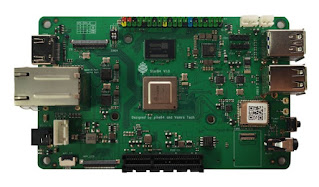Revolutionizing the Single-Board Computer Market: RISC-V Launches the First Open-Source RSBC on April 4
In recent years, there has been a growing interest in single-board computers, which are compact and low-cost devices that can be used for a wide range of applications, including education, hobbyist projects, and even commercial products. These computers are typically based on well-established architectures such as ARM or x86, but a new player is entering the market: the RISC-V architecture.
RISC-V stands for Reduced Instruction Set Computer - Five, and it is an open-source architecture that was first introduced in 2010. The RISC-V Foundation, a non-profit organization that promotes the development and adoption of RISC-V, was established in 2015, and since then, the architecture has gained significant traction in the industry.
On April 4, 2023, the first RISC-V-based single-board computer will be launched, and it promises to offer a range of benefits over traditional architectures. Here are some of the key advantages of RISC-V:
Open-source: RISC-V is an open-source architecture, which means that anyone can access the specifications, modify them, and create their own implementations. This is in contrast to proprietary architectures like ARM or x86, which are owned by specific companies and have limited flexibility.
Customizability: Because RISC-V is open-source, it is highly customizable. Developers can select the instructions that are most relevant to their specific application, and they can even create their own custom instructions. This can result in significant performance improvements and energy savings.
Scalability: RISC-V is designed to be scalable, meaning that it can be used in a wide range of devices, from small embedded systems to high-performance servers. This makes it an attractive choice for companies that want to create a single architecture that can be used across their entire product line.
Security: RISC-V is designed with security in mind, and it includes features such as hardware-enforced memory protection, which can help prevent security vulnerabilities.
The new RISC-V-based single-board computer that will be launched on April 4 is called the RISC-V Single Board Computer (RSBC), and it is being developed by a company called RISC-V International. The RSBC will be based on the SiFive Freedom U740 SoC, which is a powerful and highly customizable chip that includes a RISC-V processor.
The RSBC is designed for a wide range of applications, including education, IoT, robotics, and more. It includes a range of interfaces, including Ethernet, USB, HDMI, and GPIO, and it can run a variety of operating systems, including Linux.
The launch of the RISC-V-based single-board computer is an exciting development for the industry. With its open-source, customizable, and scalable architecture, RISC-V has the potential to disrupt the single-board computer market and provide a range of benefits to developers and end-users alike. If you're interested in learning more about RISC-V and the RSBC, be sure to check out the launch on April 4!
RISC-V is a relatively new architecture, but it has been gaining traction in the industry due to its open-source nature and flexibility. Unlike traditional architectures like ARM and x86, which are owned by specific companies and have limited customizability, RISC-V allows developers to modify and customize the instruction set to suit their specific needs.
This customizability is possible because RISC-V is designed with a modular approach. Instead of a fixed instruction set, RISC-V defines a base set of instructions that are necessary for basic operations, and additional instructions can be added as needed. This means that developers can choose the instructions that are most relevant to their application and leave out the ones they don't need.
In addition to customizability, RISC-V also offers scalability. The architecture is designed to be used in a wide range of devices, from small embedded systems to high-performance servers. This makes it an attractive choice for companies that want to create a single architecture that can be used across their entire product line.
RISC-V also includes features designed with security in mind, such as hardware-enforced memory protection. This can help prevent security vulnerabilities and ensure that data is kept safe.
The RSBC is the first single-board computer based on RISC-V, and it is being developed by RISC-V International, a non-profit organization that promotes the development and adoption of RISC-V. The RSBC is based on the SiFive Freedom U740 SoC, which is a powerful and highly customizable chip that includes a RISC-V processor.
The RSBC includes a range of interfaces, including Ethernet, USB, HDMI, and GPIO, making it suitable for a wide range of applications. It can run a variety of operating systems, including Linux, and it comes with pre-installed software that makes it easy to get started with development.
Overall, the launch of the RSBC is an exciting development for the industry, as it represents the first step towards a new era of open-source and customizable single-board computers. With its flexible architecture and powerful features, the RSBC has the potential to provide significant benefits to developers and end-users alike.







No comments